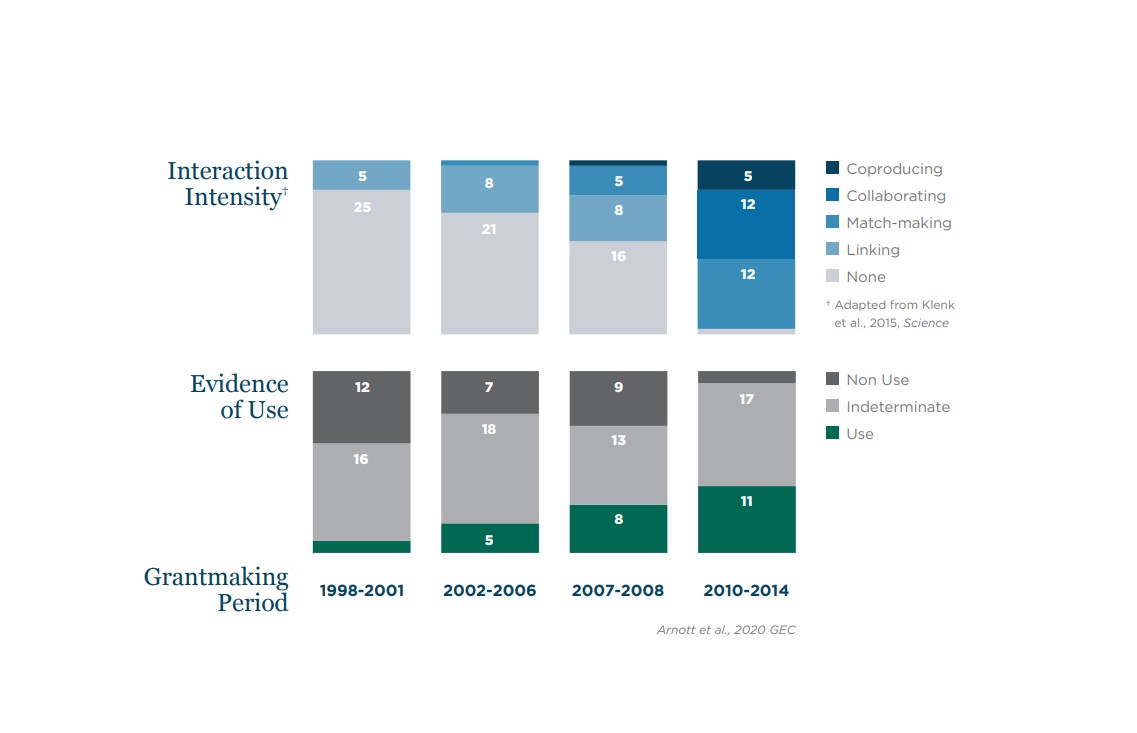Written by:
James Arnott
It feels like we’re at an inflection point for innovation in how we do research. Doing science with and for society, to borrow a phrase from a recent EU funding program, is reordering motivations and methods for many across the research enterprise worldwide. Like me, many hold great expectations that this shift will open up new possibilities for how evidence is used to inform policy and practice, and also transform the underlying culture of how we make and mobilize knowledge.
But we can’t take inflection points for granted. Change will not hold fast unless it engages directly with the power structures that hold the system in place. In this blog, I examine some of the positive initiatives that are helping to transform research and evidence systems and where we need to pay attention in order to harness, direct, and sustain momentum.
A genuine change?
We should exercise caution when characterizing the innovative nature of the current moment. The exuberance many researchers and their employers express around collaboration and co-production is, in some ways, reinventing fire. Indigenous and other traditions have long emphasized holistic, community-connected approaches, Louis Pasteur and others championed use-inspired methods in the 19th century, and community based participatory research has a rich history of development beginning in the 20th century through today.
Even so, the global movement for engaged research underway right now is revolutionary when contrasted with individualistic and siloed practices dominant across much of the modern research enterprise, in primarily North American and European organizations.
It's particularly easy to see this kind of change happening from the bottom up, such as in professional societies like the American Geophysical Union (AGU), where there has been an exponential increase in abstracts submitted that focus on partnership-oriented research (Vano et al., 2017). Or in the emergence of networks of scholars and practitioners working to construct, study, and improve research-practice partnerships, such as the Transforming Evidence Network (TEN).

In addition to this bottom up enthusiasm, the potential influence of research funders in terms of changing program goals and management practices is already apparent and unfolding.
Collaborative funding
A few years ago, I studied the emergence of a collaborative funding program within the National Estuarine Research Reserve System (NERRS). Over the 16 years examined (they have now been going for nearly 24), periodic changes in the design of the funding solicitation and other program mechanics led to significant, stepwise increases in the intensity of interaction between researchers and practitioners alongside increasing, albeit more modest, amounts of evidence of the use of research for sustainable coastal management (see Figure 1). As one PI, funded over multiple generations of this program, mentioned to me during an interview, “we got inoculated with [collaboration] in phase one and it was such a successful model that we've continued.”

My interest in the role of funders deepened recently when I encountered the work of social innovation scholar Dr. Frances Westley. Westley and colleagues involved in the University of Waterloo’s Institute for Social Innovation and Resilience (WISIR) have conducted numerous historical studies on the paths and drivers of social innovation. They define these as the programs, policies, processes that “address a social problem and […] ultimately shift resource and authority flows, social routines, and cultural values of the social system...”
After looking at the social innovations related to the development of various advances such as national parks, internet, finance, and birth control, Westley and colleagues find that for social innovation to take root, hold fast, and become truly transformational, the innovation must (among other things) grow out of niches of experimentation, and even “meso” scales of programs and communities, to confront the “dynamics and institutional barriers of the system that created the problem in the first place.”
In other words, to be durable and lead to transformation, horizontal diffusion of social innovation—like we’ve seen with growing embrace of co-production across the research community such as mentioned above at AGU—requires a complementary vertical spread through the power structures that help lock-in and reorder institutional practices. To me, this is a crucial insight to consider when figuring out how to propel us beyond the current inflection point into a space of real transformative potential. To activate the vertical spread, there is much work to be done to diffuse these innovations upward through the powers that be.
Transformational change
I’m excited to think about how research funders might help with this essential vertical dimension. More than just wielding a checkbook, research funding organizations and the dedicated professionals who staff them, can engage in “institutional entrepreneurship.”
For instance, funders can take experiments happening at niche scales, such as an annual funding program, learn from them systematically, and translate that knowledge into meso and system-wide scales. They can also engage in grass-tops peer learning as some are already doing through the Transforming Evidence Funders Network, which can further facilitate diffusion and the reorderingreording of practices not just within single organizations but within the DNA of science funding institutions at-large. More practically, as I’ve found with colleagues through a reviews of the literature, program managers working for funders often have opportunities for innovation right at their finger tips by modifying solicitation texts, revising panel review processes and compositions, providing additional support to project teams beyond financial, and augmenting evaluation and learning routines to better learn what happened from funded research.
In this way, research funders become an ideal collaborator and field site for advancing research on research use, or what many of my colleagues and I like to call the science of actionable knowledge. For instance, the only way I was able to learn as much as I did from NERRS was through close collaboration with their funding program managers and gracious access to their dataset of reports.
Of course, social innovation does not always lead to beneficial social change and recruiting and collaborating with research funders carries risks. For instance, some well-intentioned moves to change funding solicitation and selection processes can result in more superficial attention to research impact — ,
Systemic change
To address these risks, funders need to become part of a larger conversation on how engaged research processes and the science-policy interface is governed. Some are already doing this through the Transforming Evidence Funders Network, and a recent workshop on this topic at the Aspen Global Change Institute.
Ultimately, if moves toward engagement are still trapped within the logic of our historically self-governed science system that privileges researcher autonomy, there is a risk of losing traction at the tipping point’s precipice and backsliding into more conventional patterns. In a recent paper from the Science of Actionable Knowledge collective I participate in, the question of how to govern the growing space of research engagement in policy and practice was identified as top priority for the meta discipline of research on research use (Jagannathan et al., 2023).
I’m just beginning to glean from the WISIR team and others’ work on myriad examples of social innovation succeeding, floundering, or even succeeding in ways that do social harm. Research funders are just one pillar advocates for a more engaged and collaborative research enterprise must interact with. I am encouraged by signs of progress already emerging that many research funders are eager to collaborate, innovate, and help in this process of transformation.
James Arnott is Executive Director of Aspen Global Change Institute and co-founded and co-leads the Science of Actionable Knowledge, a working group of social scientists studying the drivers of knowledge use.
Header photo by Soliman Cifuentes on Unsplash